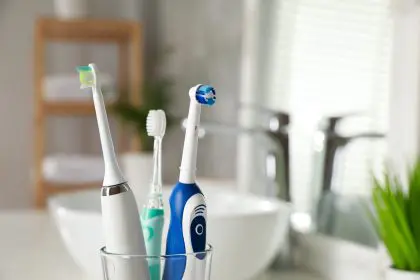That minty fresh feeling could come with an unexpected health consequence many aren’t aware of.
The surprising link between mouthwash and hypertension
The daily health routines we follow without question sometimes harbor unexpected risks. Among these, the habit of vigorously swishing antiseptic mouthwash might be silently contributing to elevated blood pressure levels for millions of Americans. This connection, while not widely known among consumers, represents a growing area of concern among medical researchers and healthcare providers specializing in cardiovascular health.
The issue centers around how certain types of mouthwash affect the delicate ecosystem of bacteria living in our mouths. While we’ve long been conditioned to view bacteria as enemies to be eliminated, science now recognizes that many oral bacteria play vital beneficial roles in our overall health, including helping to regulate blood pressure through natural processes that occur right in our mouths.
How mouthwash disrupts your body’s natural blood pressure regulation
The mechanism connecting mouthwash to blood pressure involves nitric oxide, a molecule crucial for maintaining healthy blood vessels. Our bodies produce nitric oxide through multiple pathways, and one significant pathway begins in the mouth. Certain beneficial bacteria residing on the tongue and in other oral tissues convert dietary nitrates (found in leafy greens and beets) into nitrites. When swallowed, these nitrites further convert into nitric oxide in the bloodstream.
Nitric oxide serves as a vasodilator, signaling blood vessels to relax and widen, which reduces resistance to blood flow and lowers blood pressure. This natural process represents one of the body’s primary methods for regulating healthy blood pressure levels throughout the day.
Strong antiseptic mouthwashes, particularly those containing chlorhexidine or high alcohol content, kill bacteria indiscriminately – both harmful cavity-causing varieties and beneficial species that support cardiovascular health. When these beneficial bacteria populations are dramatically reduced through regular mouthwash use, the oral nitrate-to-nitrite conversion process becomes impaired, potentially leading to reduced nitric oxide production.
The 7 types of mouthwash most likely to affect blood pressure
- Chlorhexidine mouthwashes
Prescription-strength chlorhexidine rinses show the strongest evidence for disrupting oral bacteria involved in nitric oxide production. These products, while effective against gingivitis, have demonstrated measurable effects on blood pressure in research settings. Typically prescribed for short-term use following dental procedures, extended use might pose unnecessary cardiovascular risk.
- High-alcohol content antiseptic rinses
Many over-the-counter mouthwashes contain alcohol concentrations ranging from 18-26%. These products effectively kill bacteria through protein denaturation, but this broad antibacterial action doesn’t distinguish between harmful and beneficial bacteria. Regular use of high-alcohol mouthwashes potentially creates an ongoing disruption in the oral microbiome.
- Products with cetylpyridinium chloride (CPC)
This common antimicrobial ingredient offers effective plaque control but, like other broad-spectrum antiseptics, affects beneficial bacteria populations alongside harmful ones. Its persistence in the mouth after rinsing extends both its therapeutic effects and potential microbiome disruption.
- Traditional antiseptic mouthwashes with multiple active ingredients
Many popular brands combine several antiseptic compounds to enhance their bacteria-killing properties. This cocktail approach might amplify adverse effects on nitric oxide-producing bacteria by attacking them through multiple mechanisms simultaneously.
- “Total care” formulations advertising 12-hour protection
Products promising extended protection typically contain ingredients designed to remain active in the mouth for many hours. This prolonged antimicrobial activity leaves little opportunity for beneficial bacteria recovery between uses, potentially creating a perpetual state of microbiome disruption.
- Zinc chloride containing rinses
While zinc provides benefits for reducing volatile sulfur compounds responsible for bad breath, it also possesses antibacterial properties that may affect nitric oxide-producing bacteria when used frequently.
- Triclosan-containing products
Though less common now due to regulatory concerns, some international markets still offer mouthwashes containing triclosan. This broad-spectrum antimicrobial has shown particular potency against many bacterial species, including potential disruption of beneficial oral bacteria.
Signs your mouthwash might be affecting your blood pressure
People most vulnerable to mouthwash-related blood pressure effects often exhibit certain patterns. Individuals who use antiseptic mouthwash multiple times daily, exceeding recommended usage levels in pursuit of constant fresh breath, face increased risk due to sustained suppression of beneficial oral bacteria.
Those who swish for extended periods (longer than 30-60 seconds) or who use mouthwash immediately after consuming nitrate-rich foods might be inadvertently minimizing the beneficial cardiovascular effects of their diet. The timing creates a scenario where bacteria are eliminated precisely when they would normally be processing dietary nitrates.
People already managing hypertension through medication might notice reduced effectiveness of their treatment regimen after initiating a new mouthwash habit. This pattern emerges because the medication and disrupted nitric oxide pathways may affect the same physiological systems.
Monitoring blood pressure readings before and after changes in oral hygiene routines can reveal potential connections. Some individuals observe blood pressure elevations within days of beginning regular antiseptic mouthwash use, with readings returning to previous levels after discontinuation.
Experiencing light-headedness after beginning a new mouthwash routine, particularly in people with generally low or well-controlled blood pressure, might indicate systemic effects on cardiovascular regulation mechanisms.
Better alternatives that protect oral health without raising blood pressure
- Saline rinses
Simple salt water rinses (about 1/2 teaspoon salt in 8 ounces of warm water) provide gentle antimicrobial properties and promote gum health without decimating beneficial bacteria populations. The osmotic effect helps reduce inflammation while maintaining ecological balance in the mouth.
- Targeted probiotic oral care products
Newer probiotic-containing mouthwashes aim to balance the oral microbiome rather than sterilize it. These products introduce beneficial bacteria strains that may help maintain nitric oxide production while still addressing issues like bad breath and gum inflammation.
- Alcohol-free essential oil rinses
Essential oils like tea tree, peppermint, and thyme provide antimicrobial benefits with more selectivity than broad-spectrum antiseptics. These natural alternatives can address oral health concerns while potentially preserving more beneficial bacterial populations.
- Baking soda rinses
Diluted baking soda (sodium bicarbonate) rinses help neutralize acids and reduce specific cavity-causing bacteria without the broad antimicrobial action of antiseptic mouthwashes. The alkaline environment also discourages growth of certain harmful bacteria while being gentler on beneficial species.
- Hydroxyapatite rinses
These newer formulations help remineralize tooth enamel and form protective barriers against harmful bacteria without antibacterial agents that disrupt the entire oral microbiome. They address tooth sensitivity and protection needs through physical rather than antimicrobial means.
- Green tea rinses
Cooling and swishing with unsweetened green tea provides gentle antimicrobial and anti-inflammatory benefits from natural catechins. These compounds show some selectivity in their antimicrobial action, potentially preserving more beneficial bacterial species.
- Mechanical cleaning instead of chemical approaches
For many people, thorough brushing, flossing, and tongue cleaning provides sufficient oral hygiene without any mouthwash. Water flossers, interdental brushes, and quality sonic toothbrushes can achieve excellent cleaning through mechanical removal rather than chemical killing of bacteria.
When to consult health professionals about your mouthwash habits
Discussing mouthwash use becomes particularly important during hypertension treatment. Primary care providers adjusting blood pressure medications should ask about oral hygiene routines, as mouthwash habits might explain unexpected variations in treatment effectiveness.
People experiencing unexplained blood pressure increases despite medication adherence and lifestyle management should evaluate all aspects of their health routines, including oral care products. Sometimes, a simple change to mouthwash habits creates measurable improvements.
Individuals with cardiovascular disease risk factors beyond hypertension, such as family history, diabetes, or high cholesterol, should approach antimicrobial mouthwash use cautiously. The potential blood pressure effects might compound other cardiovascular risk factors in ways that warrant special consideration.
Dentists can provide personalized recommendations balancing oral health needs with cardiovascular considerations. For patients requiring antimicrobial mouthwash for specific dental conditions, dentists might recommend limited-duration use, lower concentration products, or alternative approaches that minimize systemic effects.
Creating a blood pressure-friendly oral care routine
A truly comprehensive approach to both oral health and blood pressure management incorporates several elements. Timing mouthwash use strategically can minimize cardiovascular impacts while maintaining oral health benefits. Avoiding mouthwash use immediately after consuming nitrate-rich vegetables allows beneficial bacteria to process these compounds before being disrupted.
Incorporating more nitrate-rich foods into your diet potentially helps offset any reduction in nitric oxide production caused by antiseptic mouthwash. Leafy greens, beets, celery, and arugula provide dietary substrate for the oral nitrate-nitrite-nitric oxide pathway.
For those dealing with bad breath concerns, addressing root causes often eliminates the perceived need for strong antiseptic mouthwashes. Conditions like post-nasal drip, tonsil issues, or gastrointestinal reflux frequently contribute to breath problems and respond better to targeted medical treatment than to oral antiseptics.
Breaking the psychological dependence on the intense “burn” or extreme minty sensation that many associate with effective oral care represents an important step. These sensations, usually from alcohol or strong flavoring agents, don’t correlate with actual oral health benefits and may drive overuse of potentially problematic products.
Developing strategic mouthwash use patterns, such as reserving stronger products for occasional use rather than daily application, helps maintain both oral and cardiovascular health. This balanced approach recognizes that different situations might call for different oral care strategies.
Broader implications for health and product marketing
The mouthwash-blood pressure connection highlights a larger pattern in consumer health products. Many personal care items developed before modern microbiome understanding reflect outdated “scorched earth” approaches to bacteria. Products designed to kill all bacteria indiscriminately now appear increasingly misaligned with current scientific understanding of microbial ecosystems and health.
Consumer education regarding realistic oral health expectations needs updating to reflect contemporary science. The notion that a healthy mouth should be sterile or that constant antiseptic use constitutes optimal care contradicts current understanding of oral ecology and health.
Product marketing sometimes creates oral health anxieties that drive consumers toward unnecessary antimicrobial product use. Claims suggesting that normal mouth odors following meals indicate poor hygiene or that constant mint breath represents the only socially acceptable standard drive overuse of products that may affect cardiovascular health.
Regulatory standards for mouthwash marketing claims remain limited regarding potential systemic effects. While products undergo safety testing, longer-term physiological impacts like blood pressure effects typically fall outside traditional regulatory evaluation frameworks.
The future of oral care and cardiovascular health
Ongoing research continues exploring connections between oral bacteria and systemic health benefits. Beyond blood pressure regulation, scientists are investigating how oral bacteria influence inflammation, immune function, and other aspects of cardiovascular health.
Next-generation oral care products that selectively target harmful bacteria while preserving beneficial species represent a promising development area. These products would maintain oral health without disrupting important physiological processes like nitric oxide production.
Personalized approaches to oral care based on individual microbiome analysis might eventually replace one-size-fits-all product recommendations. This precision approach would optimize both oral and cardiovascular health outcomes through tailored product selection.
Integration of oral health considerations into cardiovascular care protocols may increase as awareness of these connections grows. Cardiologists might eventually routinely inquire about mouthwash habits alongside other lifestyle factors affecting heart health.
The evolving understanding of oral-systemic health connections emphasizes the interconnectedness of seemingly unrelated body systems. This holistic perspective encourages considering unexpected consequences of even routine health practices like mouthwash use.
For most people, the best approach involves balancing oral hygiene needs with awareness of potential systemic effects. By choosing appropriate products, using them judiciously, and maintaining perspective on realistic oral health expectations, individuals can maintain both fresh breath and healthy blood pressure.
















